英语语法——解读部分倒装与完全倒装
部分倒装和完全倒装

英语中的倒装句分为部分倒装和完全倒装一、部分倒装部分倒装亦称“助动词倒装”,是指把谓语的一部分(即助动词)提到主语的前面,而句子的其他部分仍出现在主语后面。
如果句子中没有助动词,则增加do,did,does。
如OnlyyesterdaydidIrealizewhatwasgoingon.部分倒装分为以下几类:1.句首状语为否定词not,never,no等,或具有否定意义的副词如little,hardly,seldom等时,句子部分倒装。
E.g.NeverhaveIfoundhiminsuchagoodmood。
我从未见他情绪这么好过。
NotoncehaveVesuviusstoppedhurlingpumicestonesandashintotheair.维苏维火山没有停止向空气中喷发浮石和灰尘。
Scarcelyhadhefinishedspeakingwhenthepoliceofficersrushontotheplatform.他刚刚说完,警察就冲到了平台上。
Hardlyhadwestartedwhenitbegantorain.我们刚刚出发,就开始下雨了。
Littledidheknowtherealsituation.他一点也不知道实际情况。
(在这些结构中,否定表达可出现在句中稍后一些的位置而不必倒装。
) NodifficultintheworldcandauntaCommunist.天下事难不倒共产党员。
Onnoaccountarevisitorsallowedtofeedtheanimals.禁止游客给动物投食。
(句中含no的表达大多是为了强调。
在这些结构中,否定表达可以出现在句子中靠后一些的位置,而句子不必倒装。
)2.Hardly(scarcely) …when(before),nosooner…than引导的部分在句首要倒装。
这些句子所表达的是一个动作紧接着另一个动作发生。
NosoonerhadIlaindownthanthetelephonerang.我刚躺下,电话铃就响了。
英语全部倒装和部分倒装

倒装分全部倒装和部份倒装之迟辟智美创作1、完全倒装(Full Inversion):又称"全部倒装",是指将句子中的谓语全部置于主语之前.此结构通常只用于一般现在时和一般过去时.谓语+主语+……①There be(的各种形式)+主语(+地址或时间状语)例子:There are brids singing in the tree.鸟儿在树上唱歌.②副词小品词+谓语动词+名词主语+……例子:Out rushed a young lady.③过去分词或现在分词+be的各种形式+主语+……例子:2.部份倒装(Partial Inversion)(又称半倒装句):指将谓语的一部份如助动词或情态动词倒装至主语之前,而谓语动词无变动.如果句中的谓语没有助动词或情态动词,则需添加助动词do,does或did,并将其置于主语之前.英语句子的倒装一是由于语法结构的需要而进行的倒装,二是由于修辞的需要而进行的倒装.前一种情况,倒装是必需的,否则就会呈现语法毛病;后一种情况,倒装是选择性的,倒装与否只会发生表达效果上的不同.暗示强调倒装句最突出、最罕见的修辞效果就是强调,其暗示形式如下:1.only +状语或状语从句置于句首,被该状语修饰的句子用部份倒装.例子:Only in this way can you solve this problem.只有用这种方法,你才可以解决这个问题.Only after he had spoken out the word did he realize he had made a big mistake.只有当他已经说出那个字后才意识到自己犯了个年夜毛病.2. hardly,in no way,little,scarcely,seldom,never,no more,no longer,not,not only,no sooner,not only … (but also),not until… 等具有否定意义的词或词组位于句首,句子用部份倒装.例子:No sooner had I got home than it began to rain.我刚抵家就下起了雨.Seldom do I go to work by bus.我很少乘公共汽车上班.Not until twelve o'clock did she go to bed last night .她昨晚十二点才上床睡觉.3. so / such...that结构中的so或such位于句首可以构成部份倒装句,暗示强调so /such和that之间的部份.例子:So unreasonable was his price that everybody startled.他的要价太离谱,令每个人都张口结舌.上句用倒装语序突出了句首成份,其语气较自然语序强烈,因而具有极佳的修辞效果.4.某些副词开头的句子构成的完全倒装here、there、now、then、thus等副词开头的句子可构成完全倒装.条件是谓语动词是不及物动词,如arise、be、come、exist、go、follow等.需要注意的是,当主语是代词时,不能构成倒装.(方位词在句首,主语是名词,全部倒装)例子:Here comes our headmaster.我们的校长来了.Here it is. 在这里.Here is your key.这是你的钥匙.承先启后部份内容不需要的重复,经常使用"so+be动词(助动词、情态动词)+主语"或"neither/nor + be动词(助动词、情态动词)+主语"的倒装句式.其中第一个句式暗示"与前面所述的肯定情况相同",第二个句式暗示"与前面所述的否定情况相同".例子:A:His brother is(not) a college student; B:so is mine.(nor is mine .)A:他弟弟(不)是年夜学生,B:我弟弟也是.(我弟弟也不是.) A:He used to have his further study abroad; B:so did I.(neither did I.)A:他曾去国外深造过.B:我也去过.(我也没有.)可以概括成:主语相同不倒装,主语分歧倒装.英语修辞的一个重要原则是尾重原则,即把句子最复杂的成份放在句尾以坚持句子平衡.在语言使用中为了防止发生头重脚轻、结构不服衡的句子,我们常采纳倒装语序.1. 以作状语的介词短语开头:当主语较长或主语所带修饰语较长时,为了使句子平衡,常将状语置于句首,句子用完全倒装语序.A. On the ground lay some air conditioners,which are to be shipped to some other cities.B. Some air conditioners lay on the ground,which are to be shipped to some other cities.地上放着一些空调,等着用船运到其他城市去.例句(1)包括一个非限制性定语从句,B句未倒装,则从句的先行词与引导词which中间被状语分隔开,不容易于理解,而A句倒装使得先行词air conditioner与引导词which 的关系一目了然.从例句中可看出,采纳倒装语序的A句结构平衡稳妥,读起来自然流畅,而采纳自然语序的B句结构零乱,读起来也别扭.因而,在主语较长时就应采纳倒装语序以取得理想的表达效果.2. 以表语开头的句子:有时为了把较长的主语放在后面,须将表语和谓语都提到主语前.例子:Such would be our home in the future.我们家就将是这个样子.3. 以副词here,there开头的句子,也采纳完全倒装来坚持句子平衡.例子:Here is the letter you have been looking forward to.你盼望已久的信在这儿。
英语中的完全倒装和局部倒装
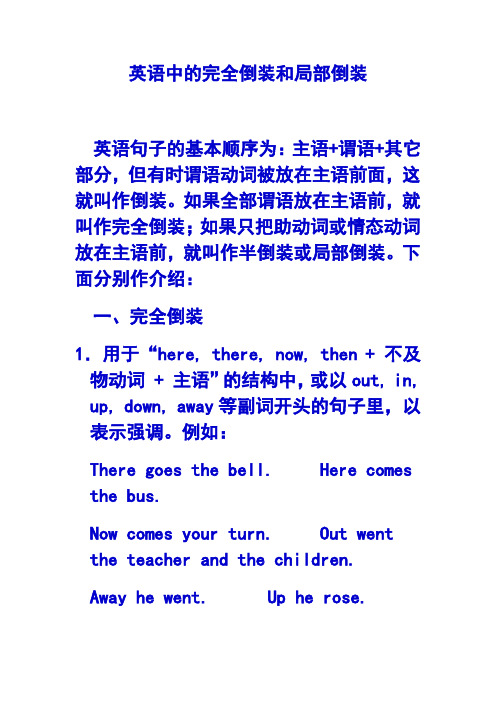
英语中的完全倒装和局部倒装英语句子的基本顺序为:主语+谓语+其它部分,但有时谓语动词被放在主语前面,这就叫作倒装。
如果全部谓语放在主语前,就叫作完全倒装;如果只把助动词或情态动词放在主语前,就叫作半倒装或局部倒装。
下面分别作介绍:一、完全倒装1.用于“here, there, now, then + 不及物动词 + 主语”的结构中,或以out, in, up, down, away等副词开头的句子里,以表示强调。
例如:There goes the bell. Here comes the bus.Now comes your turn. Out went the teacher and the children.Away he went. Up he rose.2.用于“there be”的结构中,例如:There were many boys and girls on the playground just now.There will be a new station near our school.3.当介词短语或地点状语放在句首作状语时,例如:North of the city lies/is a new airport.From the valley came a frightening sound with some cries.4.表语放句首时倒装结构为:“表语+连系动词+主语”,例如:Present at the meeting is our English teacher.Gone are the days when we had a good time at the mountain village.In the middle of the room stand twodesks and some chairs for the party.5.当“so/such… that”结构中的so或such 位于句首时,例如:So beautiful was she that many men would like to dance with her at the party.Such an honest boy is he that he gave back the change to me after shopping.6.用于so, nor, neither开头的句子,表示重复前面的内容,原句的谓语应与前面的谓语动词的时态、形式等相一致。
【英语知识点】部分倒装与完全倒装的区别
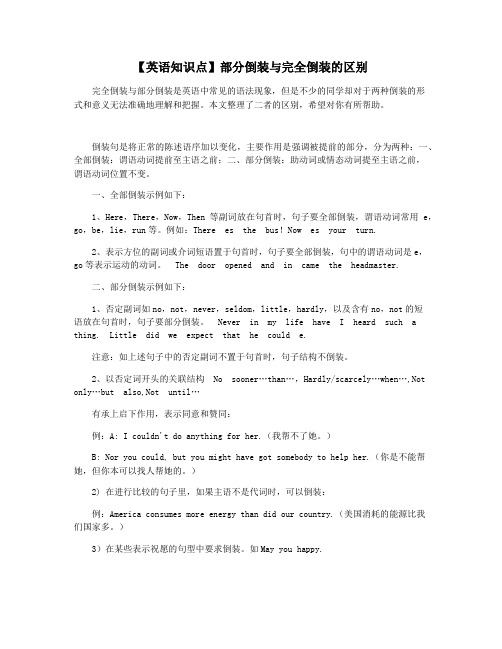
【英语知识点】部分倒装与完全倒装的区别完全倒装与部分倒装是英语中常见的语法现象,但是不少的同学却对于两种倒装的形式和意义无法准确地理解和把握。
本文整理了二者的区别,希望对你有所帮助。
倒装句是将正常的陈述语序加以变化,主要作用是强调被提前的部分,分为两种:一、全部倒装:谓语动词提前至主语之前;二、部分倒装:助动词或情态动词提至主语之前,谓语动词位置不变。
一、全部倒装示例如下:1、Here,There,Now,Then等副词放在句首时,句子要全部倒装,谓语动词常用e,go,be,lie,run等。
例如:There es the bus!Now es your turn.2、表示方位的副词或介词短语置于句首时,句子要全部倒装,句中的谓语动词是e,go等表示运动的动词。
The door opened and in came the headmaster.二、部分倒装示例如下:1、否定副词如no,not,never,seldom,little,hardly,以及含有no,not的短语放在句首时,句子要部分倒装。
Never in my life have I heard such a thing. Little did we expect that he could e.注意:如上述句子中的否定副词不置于句首时,句子结构不倒装。
2、以否定词开头的关联结构No sooner…than…,Hardly/scarcely…when…,Not only…but also,Not until…有承上启下作用,表示同意和赞同:例:A: I couldn't do anything for her.(我帮不了她。
)B: Nor you could, but you might have got somebody to help her.(你是不能帮她,但你本可以找人帮她的。
)2) 在进行比较的句子里,如果主语不是代词时,可以倒装:例:America consumes more energy than did our country.(美国消耗的能源比我们国家多。
英语语法倒装
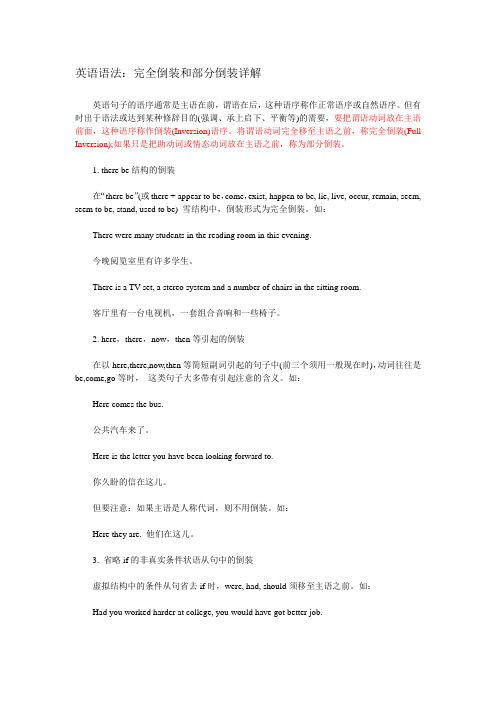
英语语法:完全倒装和部分倒装详解英语句子的语序通常是主语在前,谓语在后,这种语序称作正常语序或自然语序。
但有时出于语法或达到某种修辞目的(强调、承上启下、平衡等)的需要,要把谓语动词放在主语前面,这种语序称作倒装(Inversion)语序。
将谓语动词完全移至主语之前,称完全倒装(Full Inversion);如果只是把助动词或情态动词放在主语之前,称为部分倒装。
1. there be结构的倒装在“there be”(或there + appear to be,come,exist, happen to be, lie, live, occur, remain, seem, seem to be, stand, used to be) 雪结构中,倒装形式为完全倒装。
如:There were many students in the reading room in this evening.今晚阅览室里有许多学生。
There is a TV set, a stereo system and a number of chairs in the sitting room.客厅里有一台电视机,一套组合音响和一些椅子。
2. here,there,now,then等引起的倒装在以here,there,now,then等简短副词引起的句子中(前三个须用一般现在时),动词往往是be,come,go等时,这类句子大多带有引起注意的含义。
如:Here comes the bus.公共汽车来了。
Here is the letter you have been looking forward to.你久盼的信在这儿。
但要注意:如果主语是人称代词,则不用倒装。
如:Here they are. 他们在这儿。
3. 省略if的非真实条件状语从句中的倒装虚拟结构中的条件从句省去if时,were, had, should须移至主语之前。
英语语法解读部分倒装与完全倒装

[初中英语倒装句讲解]英语语法——解读部分倒装与完全倒装篇一: 英语语法——解读部分倒装与完全倒装部分和完全倒装有什么不同?看看下面的讲解是否明白?部分只需要把助动词提前其他句子结果不变全部倒装呢则是要把谓语提前句子其他位置不边部分倒装所谓的助动词意思我举个小列子你就懂了I went to home .这里谓语就是went相应的组动词就是did部分倒装:Did I go to home.完全倒装:Went I to home.1. 完全倒装1) 完全即把整个谓语放到主语之前。
there引出的完全倒装句:除了最常见的there be句型以外,there还可以接appear, exist, lie, remain, seem to be, stand等,一般都译成”有”的含义,构成完全倒装句。
例如:There appeared to be a man in black in the distance.3) 由地点和时间副词引出的完全句:以地点副词here, there和时间副词now, then 开头,后面的动词是be, come, exist, fall, follow, go, lie, remain, seem, stand等,而主语又是名词时,构成完全倒装句。
例:Under that tree sits a beautiful girl. 例:_________ from thetenth floor when the policeman pointed his pistol at him.A) Jumped down the burglar B) Down the burglar jumpedC) The burglar jumps down D) Down jumped the burglar答案是D) Down jumped the burglar。
因为地点状语Down位于句首应该用完全倒装,整个谓语动词应位于主语之前。
完全倒装与部分倒装

完全倒装与部分倒装完全倒装和部分倒装是英语语法中常见的句式结构,它们在句子中对主语和谓语进行了调换,使得句子的表达形式有所不同。
本文将对完全倒装和部分倒装进行详细介绍和区分,并给出相关的例句以更好地理解和掌握这两种句式。
一、完全倒装的定义、结构和用法完全倒装是指把句子中的主语和谓语调换位置,使得谓语动词或短语位于主语之前。
完全倒装常用于以下几种情况:1. 在以介词短语作状语的情况下,为了强调地点、时间等状语信息。
例如:Out of the box jumped a cute little kitten.(一只可爱的小猫跳出了盒子。
)In front of the house stood a tall tree.(一棵高大的树矗立在房子前。
)2. 在表示地点或时间的副词或短语放在句首时。
例如:Here comes the bus.(汽车来了。
)Now is the time to act.(是时候采取行动了。
)3. 在以表示否定意义的副词或短语开头的情况下。
例如:Never have I seen such a beautiful sunset.(我从来没有见过如此美丽的日落。
)Not until yesterday did I realize the importance of learning.(直到昨天我才意识到学习的重要性。
)二、部分倒装的定义、结构和用法部分倒装是指只把助动词、情态动词或是be动词短语放在主语前面。
部分倒装常用于以下几种情况:1. 在以否定词开头的句子中,特别是在表示否定意义的副词或短语后面。
例如:Never before have I seen such a magnificent building.(我从未见过如此壮观的建筑。
)Rarely do we have such an opportunity.(我们很少有这样的机会。
)2. 在表示条件的虚拟句型中。
例如:Had I known the truth, I would have acted differently.(要是我当时知道真相,我会采取不同的行动。
完全倒装与部分倒装
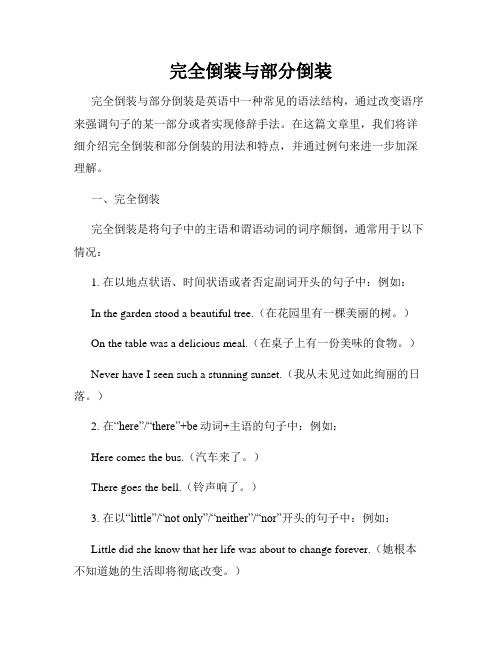
完全倒装与部分倒装完全倒装与部分倒装是英语中一种常见的语法结构,通过改变语序来强调句子的某一部分或者实现修辞手法。
在这篇文章里,我们将详细介绍完全倒装和部分倒装的用法和特点,并通过例句来进一步加深理解。
一、完全倒装完全倒装是将句子中的主语和谓语动词的词序颠倒,通常用于以下情况:1. 在以地点状语、时间状语或者否定副词开头的句子中:例如:In the garden stood a beautiful tree.(在花园里有一棵美丽的树。
)On the table was a delicious meal.(在桌子上有一份美味的食物。
)Never have I seen such a stunning sunset.(我从未见过如此绚丽的日落。
)2. 在“here”/“there”+be动词+主语的句子中:例如:Here comes the bus.(汽车来了。
)There goes the bell.(铃声响了。
)3. 在以“little”/“not only”/“neither”/“nor”开头的句子中:例如:Little did she know that her life was about to change forever.(她根本不知道她的生活即将彻底改变。
)Not only is he intelligent, but he is also kind-hearted.(他不仅聪明,而且心地善良。
)Neither did I agree with his decision, nor did I understand his reasoning.(我既不同意他的决定,也不理解他的理由。
)二、部分倒装部分倒装是将助动词、情态动词或者“be”动词与主语的词序颠倒,同样用于强调句子的某一部分或者实现修辞手法。
常见的部分倒装情况包括:1. 在以否定词开头的句子中:例如:Never have I been so inspired.(我从未如此受到鼓舞。
英语全部倒装与部分倒装区别讲解 多种比对

全部倒装与部分倒装区别英语句子一般主语在前,谓语在后,但有时因为语法结构的要求或由于修辞的要求,要改变句子的自然语序,把一些本应置于主语之后的成分提前,我们称这种语序为倒装语序。
解释1:部分倒装—是指将谓语的一部分如系动词,助动词或情态动词倒装至主语之前。
如果句子的谓语没有助动词或情态动词,则需添加助动词do, does或did,并将其置于主语之前。
解释2:完全倒装即把整个谓语放到主语之前In came the teacher and the class began. (老师走了进来,然后开始上课。
)部分倒装即只把谓语的一部分(如助动词、情态动词等)放到主语前,或把句子的强调成分提前。
Nor did he let the disease stop him from living the kind of life he has always dreamt about(疾病没有使他放弃过上梦想中的生活)解释3:为了表示强调,经常将never等否定副词或by no means等杏定词组放在句首,此时句子要求将系动词、助动词或情态动词放在主语之前,而谓语部分位置不变,这就是部分倒装。
Not until yesterday did little John change his mind.直到昨天小约翰才改变主意。
完全倒装是主语和谓语完全颠倒。
如;Here comes the bus. 公共汽车来了。
There goes the bell. 铃响了。
解释4:英语句子的自然语序是“主语+ 谓语”。
如果将谓语的全部或一部分放在主语之前,这种语序被称为“倒装”。
谓语全部放在主语之前,为全部倒装;只把助动词,连系动词或情态动词放在主语之前,为部分倒装。
倒装的原因,一是语法结构的需要(如某些疑问句);二是为了强调;三是保持句子的平衡或是上下文紧密相接解释5:英语句子的结构一般是“主语+ 谓语”,语法上称这种语序为自然语序。
完全倒装与部分倒装(精选)
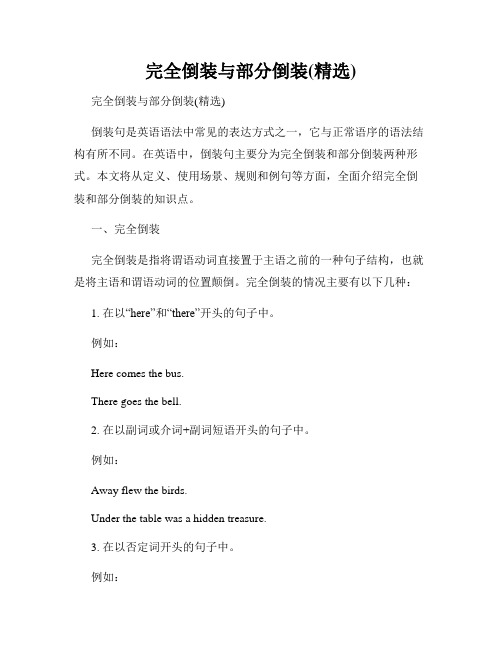
完全倒装与部分倒装(精选)完全倒装与部分倒装(精选)倒装句是英语语法中常见的表达方式之一,它与正常语序的语法结构有所不同。
在英语中,倒装句主要分为完全倒装和部分倒装两种形式。
本文将从定义、使用场景、规则和例句等方面,全面介绍完全倒装和部分倒装的知识点。
一、完全倒装完全倒装是指将谓语动词直接置于主语之前的一种句子结构,也就是将主语和谓语动词的位置颠倒。
完全倒装的情况主要有以下几种:1. 在以“here”和“there”开头的句子中。
例如:Here comes the bus.There goes the bell.2. 在以副词或介词+副词短语开头的句子中。
例如:Away flew the birds.Under the table was a hidden treasure.3. 在以否定词开头的句子中。
例如:Never have I seen such a beautiful sunset.Not only did he pass the exam, but he also got the highest score.4. 在以“only”开头的句子中。
例如:Only in this way can we solve the problem.Only when we work together can we achieve success.二、部分倒装部分倒装是指将助动词、情态动词或连系动词置于主语之前的一种句子结构。
部分倒装常常出现在以下情况下:1. 在以否定词开头的句子中。
例如:Never have I been so disappointed.At no time did she mention the incident.2. 在以“so”开头表示结果的句子中。
例如:So excited was he that he couldn't fall asleep.So tired was she that she couldn't continue the journey.3. 在以“not only...but also...”开头的句子中。
英语完全倒装和部分倒装--解决不易懂
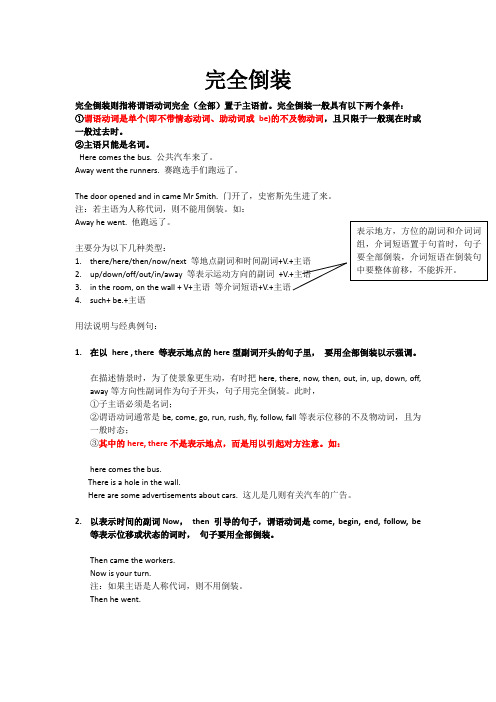
完全倒装完全倒装则指将谓语动词完全(全部)置于主语前。
完全倒装一般具有以下两个条件:①谓语动词是单个(即不带情态动词、助动词或be)的不及物动词,且只限于一般现在时或一般过去时。
②主语只能是名词。
Here comes the bus. 公共汽车来了。
Away went the runners. 赛跑选手们跑远了。
The door opened and in came Mr Smith. 门开了,史密斯先生进了来。
注:若主语为人称代词,则不能用倒装。
如:Away he went. 他跑远了。
主要分为以下几种类型:1.there/here/then/now/next 等地点副词和时间副词+V.+主语2.up/down/off/out/in/away 等表示运动方向的副词+V.+主语3.in the room, on the wall + V+主语等介词短语+V.+主语4.such+ be.+主语用法说明与经典例句:1.在以here , there 等表示地点的here型副词开头的句子里,要用全部倒装以示强调。
在描述情景时,为了使景象更生动,有时把here, there, now, then, out, in, up, down, off, away等方向性副词作为句子开头,句子用完全倒装。
此时,①子主语必须是名词;②谓语动词通常是be, come, go, run, rush, fly, follow, fall等表示位移的不及物动词,且为一般时态;③其中的here, there不是表示地点,而是用以引起对方注意。
如:here comes the bus.There is a hole in the wall.Here are some advertisements about cars. 这儿是几则有关汽车的广告。
2.以表示时间的副词Now,then 引导的句子,谓语动词是come, begin, end, follow, be等表示位移或状态的词时,句子要用全部倒装。
初中英语倒装句讲解英语语法解读部分倒装与完全倒装

[初中英语倒装句讲解]英语语法——解读部分倒装与完全倒装篇一: 英语语法——解读部分倒装与完全倒装部分和完全倒装有什么不同?看看下面的讲解是否明白?部分只需要把助动词提前其他句子结果不变全部倒装呢则是要把谓语提前句子其他位置不边部分倒装所谓的助动词意思我举个小列子你就懂了I went to home .这里谓语就是went相应的组动词就是did部分倒装:Did I go to home.完全倒装:Went I to home.1. 完全倒装1) 完全即把整个谓语放到主语之前。
there引出的完全倒装句:除了最常见的there be句型以外,there还可以接appear, exist, lie, remain, seem to be, stand等,一般都译成”有”的含义,构成完全倒装句。
例如:There appeared to be a man in black in the distance.3) 由地点和时间副词引出的完全句:以地点副词here, there和时间副词now, then 开头,后面的动词是be, come, exist, fall, follow, go, lie, remain, seem, stand等,而主语又是名词时,构成完全倒装句。
例:Under that tree sits a beautiful girl. 例:_________ from thetenth floor when the policeman pointed his pistol at him.A) Jumped down the burglar B) Down the burglar jumpedC) The burglar jumps down D) Down jumped the burglar答案是D) Down jumped the burglar。
因为地点状语Down位于句首应该用完全倒装,整个谓语动词应位于主语之前。
高中语法辨析倒装句的完全与部分倒装
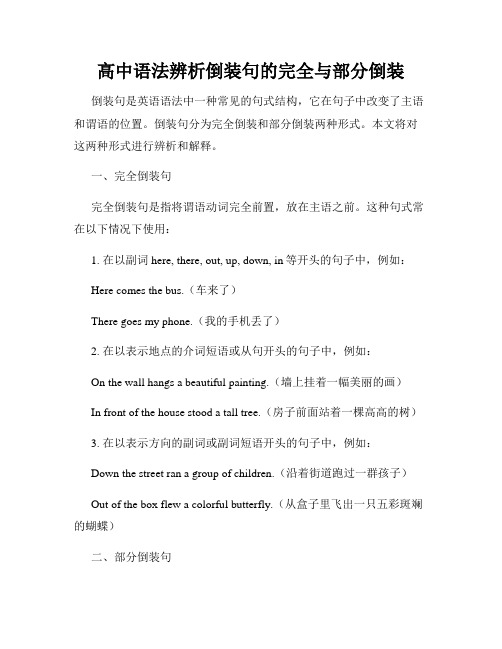
高中语法辨析倒装句的完全与部分倒装倒装句是英语语法中一种常见的句式结构,它在句子中改变了主语和谓语的位置。
倒装句分为完全倒装和部分倒装两种形式。
本文将对这两种形式进行辨析和解释。
一、完全倒装句完全倒装句是指将谓语动词完全前置,放在主语之前。
这种句式常在以下情况下使用:1. 在以副词here, there, out, up, down, in等开头的句子中,例如:Here comes the bus.(车来了)There goes my phone.(我的手机丢了)2. 在以表示地点的介词短语或从句开头的句子中,例如:On the wall hangs a beautiful painting.(墙上挂着一幅美丽的画)In front of the house stood a tall tree.(房子前面站着一棵高高的树)3. 在以表示方向的副词或副词短语开头的句子中,例如:Down the street ran a group of children.(沿着街道跑过一群孩子)Out of the box flew a colorful butterfly.(从盒子里飞出一只五彩斑斓的蝴蝶)二、部分倒装句部分倒装句是指将助动词或情态动词与主语之间的其他成分倒装,谓语动词仍然位于主语之后。
这种句式常在以下情况下使用:1. 在以表示否定意义的副词或词组开头的句子中,例如:Never have I seen such a beautiful sunset.(我从未见过如此美丽的日落)Under no circumstances should you give up.(无论如何,你都不应该放弃)2. 在以谓语动词的否定形式开头的句子中,例如:Not only does she play the piano, but she also sings.(她不仅会弹钢琴,还会唱歌)No sooner had I arrived home than it started raining.(我一到家就开始下雨)3. 在以“so + 形容词/副词 + 助动词/情态动词”结构开头的句子中,例如:So beautiful is the scenery that I want to stay here forever.(风景如此美丽,我想永远呆在这里)So quickly can he solve the math problem that it astonishes everyone.(他能如此快地解决这道数学题,让每个人都惊讶)总结:完全倒装句和部分倒装句在使用场景和结构上有所不同。
全部倒装和部分倒装知识点
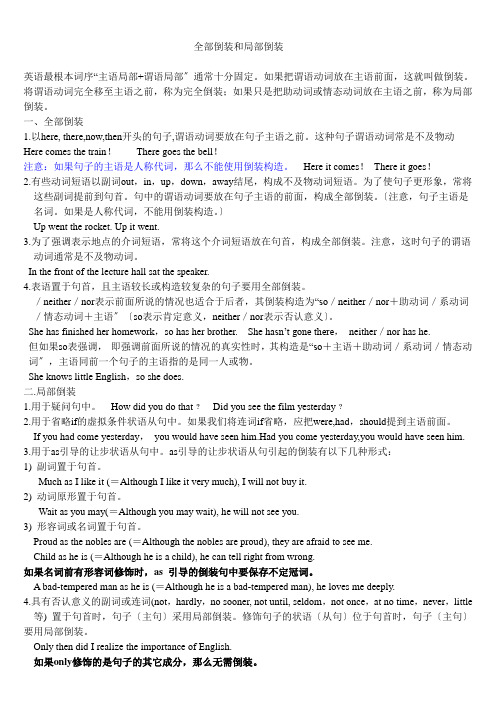
全部倒装和局部倒装英语最根本词序“主语局部+谓语局部〞通常十分固定。
如果把谓语动词放在主语前面,这就叫做倒装。
将谓语动词完全移至主语之前,称为完全倒装;如果只是把助动词或情态动词放在主语之前,称为局部倒装。
一、全部倒装1.以here, there,now,then开头的句子,谓语动词要放在句子主语之前。
这种句子谓语动词常是不及物动Here comes the train!There goes the bell!注意:如果句子的主语是人称代词,那么不能使用倒装构造。
Here it comes!There it goes!2.有些动词短语以副词out,in,up,down,away结尾,构成不及物动词短语。
为了使句子更形象,常将这些副词提前到句首。
句中的谓语动词要放在句子主语的前面,构成全部倒装。
〔注意,句子主语是名词。
如果是人称代词,不能用倒装构造。
〕Up went the rocket. Up it went.3.为了强调表示地点的介词短语,常将这个介词短语放在句首,构成全部倒装。
注意,这时句子的谓语动词通常是不及物动词。
In the front of the lecture hall sat the speaker.4.表语置于句首,且主语较长或构造较复杂的句子要用全部倒装。
/neither/nor表示前面所说的情况也适合于后者,其倒装构造为“so/neither/nor+助动词/系动词/情态动词+主语〞〔so表示肯定意义,neither/nor表示否认意义〕。
She has finished her homework,so has her brother. She ha sn’t gone there,neither/nor has he.但如果so表强调,即强调前面所说的情况的真实性时,其构造是“so+主语+助动词/系动词/情态动词〞,主语同前一个句子的主语指的是同一人或物。
She knows little English,so she does.二.局部倒装1.用于疑问句中。
英语倒装句讲解
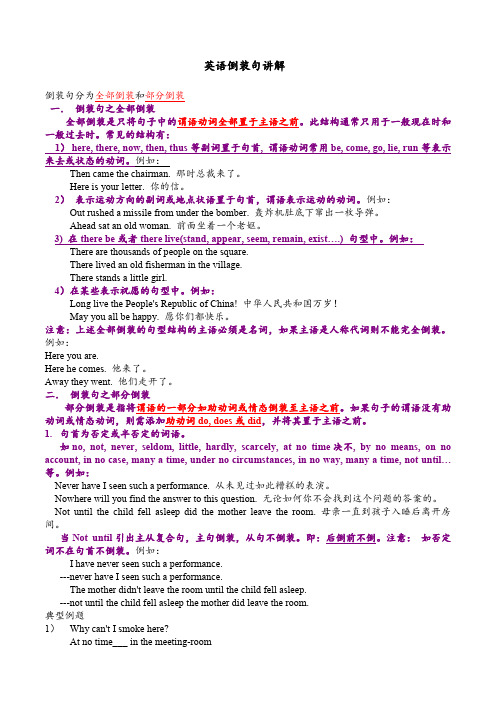
英语倒装句讲解倒装句分为全部倒装和部分倒装一.倒装句之全部倒装全部倒装是只将句子中的谓语动词全部置于主语之前。
此结构通常只用于一般现在时和一般过去时。
常见的结构有:1)here, there, now, then, thus等副词置于句首, 谓语动词常用be, come, go, lie, run等表示来去或状态的动词。
例如:Then came the chairman. 那时总裁来了。
Here is your letter. 你的信。
2)表示运动方向的副词或地点状语置于句首,谓语表示运动的动词。
例如:Out rushed a missile from under the bomber. 轰炸机肚底下窜出一枚导弹。
Ahead sat an old woman. 前面坐着一个老妪。
3) 在there be或者there live(stand, appear, seem, remain, exist….) 句型中。
例如:There are thousands of people on the square.There lived an old fisherman in the village.There stands a little girl.4)在某些表示祝愿的句型中。
例如:Long live the People's Republic of China! 中华人民共和国万岁!May you all be happy. 愿你们都快乐。
注意:上述全部倒装的句型结构的主语必须是名词,如果主语是人称代词则不能完全倒装。
例如:Here you are.Here he comes. 他来了。
Away they went. 他们走开了。
二.倒装句之部分倒装部分倒装是指将谓语的一部分如助动词或情态倒装至主语之前。
如果句子的谓语没有助动词或情态动词,则需添加助动词do, does或did,并将其置于主语之前。
完全倒装与部分倒装通用版
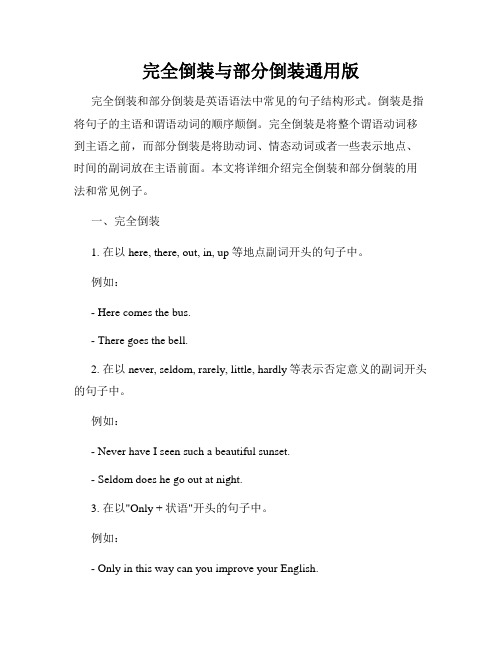
完全倒装与部分倒装通用版完全倒装和部分倒装是英语语法中常见的句子结构形式。
倒装是指将句子的主语和谓语动词的顺序颠倒。
完全倒装是将整个谓语动词移到主语之前,而部分倒装是将助动词、情态动词或者一些表示地点、时间的副词放在主语前面。
本文将详细介绍完全倒装和部分倒装的用法和常见例子。
一、完全倒装1. 在以here, there, out, in, up等地点副词开头的句子中。
例如:- Here comes the bus.- There goes the bell.2. 在以never, seldom, rarely, little, hardly等表示否定意义的副词开头的句子中。
例如:- Never have I seen such a beautiful sunset.- Seldom does he go out at night.3. 在以"Only + 状语"开头的句子中。
例如:- Only in this way can you improve your English.- Only by working hard can we achieve success.4. 在以否定词开头的句子中,如never, not, no sooner等。
例如:- Never had I tasted such delicious food.- Not until the exam is over will we be able to relax.5. 在以“so/such + adj./adv. + that”开头的句子中。
例如:- So loud was the music that we couldn't hear each other.- Such is his talent that he can play multiple instruments.6. 在以“here/now + 系动词 + 主语”开头的句子中。
句子的倒装与部分倒装
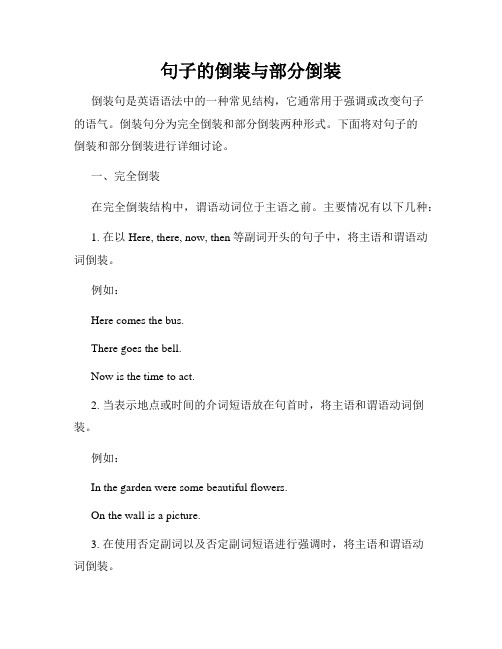
句子的倒装与部分倒装倒装句是英语语法中的一种常见结构,它通常用于强调或改变句子的语气。
倒装句分为完全倒装和部分倒装两种形式。
下面将对句子的倒装和部分倒装进行详细讨论。
一、完全倒装在完全倒装结构中,谓语动词位于主语之前。
主要情况有以下几种:1. 在以Here, there, now, then等副词开头的句子中,将主语和谓语动词倒装。
例如:Here comes the bus.There goes the bell.Now is the time to act.2. 当表示地点或时间的介词短语放在句首时,将主语和谓语动词倒装。
例如:In the garden were some beautiful flowers.On the wall is a picture.3. 在使用否定副词以及否定副词短语进行强调时,将主语和谓语动词倒装。
例如:Never have I seen such a beautiful sunset.Not only is he a great musician, but also a talented writer.4. 在祈使句中,将谓语动词放在句首。
例如:Go away!Be quiet!二、部分倒装部分倒装句是指将助动词、情态动词或者be动词与主语之间的顺序颠倒。
常见情况包括:1. 否定副词或者词组放在句首进行强调时,将助动词、情态动词或be动词与主语之间的顺序颠倒。
例如:Under no circumstances should you give up.By no means will I forgive him.2. 在条件句中,将主语和谓语中的助动词、情态动词或者be动词倒装。
例如:Had I known the truth, I wouldn't have trusted him.Should you need any help, feel free to ask.3. 在含有only, hardly, little, seldom等词的句子中,将助动词、情态动词或be动词与主语之间的顺序颠倒。
英语全部倒装与部分倒装区别讲解 多种比对

全部倒装与部分倒装区别英语句子一般主语在前,谓语在后,但有时因为语法结构的要求或由于修辞的要求,要改变句子的自然语序,把一些本应置于主语之后的成分提前,我们称这种语序为倒装语序。
解释1:部分倒装—是指将谓语的一部分如系动词,助动词或情态动词倒装至主语之前。
如果句子的谓语没有助动词或情态动词,则需添加助动词do, does或did,并将其置于主语之前。
解释2:完全倒装即把整个谓语放到主语之前In came the teacher and the class began. (老师走了进来,然后开始上课。
)部分倒装即只把谓语的一部分(如助动词、情态动词等)放到主语前,或把句子的强调成分提前。
Nor did he let the disease stop him from living the kind of life he has always dreamt about(疾病没有使他放弃过上梦想中的生活)解释3:为了表示强调,经常将never等否定副词或by no means等杏定词组放在句首,此时句子要求将系动词、助动词或情态动词放在主语之前,而谓语部分位置不变,这就是部分倒装。
Not until yesterday did little John change his mind.直到昨天小约翰才改变主意。
完全倒装是主语和谓语完全颠倒。
如;Here comes the bus. 公共汽车来了。
There goes the bell. 铃响了。
解释4:英语句子的自然语序是“主语+ 谓语”。
如果将谓语的全部或一部分放在主语之前,这种语序被称为“倒装”。
谓语全部放在主语之前,为全部倒装;只把助动词,连系动词或情态动词放在主语之前,为部分倒装。
倒装的原因,一是语法结构的需要(如某些疑问句);二是为了强调;三是保持句子的平衡或是上下文紧密相接解释5:英语句子的结构一般是“主语+ 谓语”,语法上称这种语序为自然语序。
- 1、下载文档前请自行甄别文档内容的完整性,平台不提供额外的编辑、内容补充、找答案等附加服务。
- 2、"仅部分预览"的文档,不可在线预览部分如存在完整性等问题,可反馈申请退款(可完整预览的文档不适用该条件!)。
- 3、如文档侵犯您的权益,请联系客服反馈,我们会尽快为您处理(人工客服工作时间:9:00-18:30)。
部分和完全有什么不同?看看下面的讲解是否明白?部分只需要把助动词提前其他句子结果不变全部呢则是要把谓语提前句子其他位置不边部分所谓的助动词意思我举个小列子你就懂了I went to home .这里谓语就是went相应的组动词就是did部分:Did I go to home.完全:Went I to home.1. 完全1) 完全即把整个谓语放到主语之前(是整个谓语动词,而非助动词)。
例如:In came the teacher and the class began. (老师走了进来,然后开始上课。
)2) there引出的完全句:除了最常见的there be句型以外,there还可以接appear, exist, lie, remain, seem to be, stand等,一般都译成"有"的含义,构成完全句。
例如:There appeared to be a man in black in the distance.(远处有个穿黑色衣服的人。
)3) 由地点和时间副词引出的完全句:以地点副词here, there和时间副词now, then 开头,后面的动词是be, come, exist, fall, follow, go, lie, remain, seem, stand等,而主语又是名词时,构成完全句。
例:Under that tree sits a beautiful girl.(那棵树下坐着一位美丽的姑娘。
)例:_________ from the tenth floor when the policeman pointed his pistol at him.A) Jumped down the burglar B) Down the burglar jumpedC) The burglar jumps down D) Down jumped the burglar答案是D) Down jumped the burglar。
因为地点状语Down位于句首应该用完全,整个谓语动词应位于主语之前。
C) The burglar jumps down虽然是自然语序,但时态错误,应该用和时间状语从句一致的过去时,而不是现在时。
注意:1) 在here, there引出的句中,当主语是普通名词时用完全句,但当主语是代词时,就要用部分句。
例:Here comes the postman!(邮递员终于来了!注意实意谓语动词位于主语之前。
)Here we are.(我们到了。
注意系动词位于主语代词之后。
)2) 注意正语序和语序的语气、意义是区别:例:Here is the picture I love.(这正是我所喜爱的画。
)The picture I love is here.(我所喜爱的画在这里。
)3) 当主语是代词,谓语是系动词,表语是说明性的词、词组和定语从句时,可以使用完全句,起强调作用。
例:Lucky is he who has been enrolled into a famous university.(他真幸运,被一所名牌大学录取了。
)2. 部分1) 部分即只把谓语的一部分(如助动词、情态动词等)放到主语前,或把句子的强调成分提前。
例:_______ right now, she would get there on Sunday.A) Would she leave B) if she leaveC) were she to leave D) If she had left结合选项,全句的意思是:“如果她立刻就走,她就能在星期天到达那里”。
答案是C。
2) 以否定词开头的句子要求部分。
注意下列句子中助动词或情态动词提前、甚至补充助动词的用法:例:Not until yesterday did little John change his mind.(小约翰直到昨天才改变了主意。
)例:In no country ______ Britain, it had been said, can one experience four seasons in the course of a single day.A) better than B) more than C) other than D) rather than本题是个句,答案是C) other than。
no other than意思是“正是、就是”;而rather than的意思是“宁愿……而不……;而不是”。
3) 以否定副词开头并加状语的句子要求部分。
这些否定副词有barely, hardly, little, seldom, scarcely…… when, never, no sooner…… than, rarely, no more, nor nearly, not only等以及only。
例:Only under special circumstances _________ to take make-up tests.A) are freshmen permitted C) permitted are freshmenB) freshmen are permitted D) are permitted freshmen全句的意思是:“一年级学生只有在特殊的情况下才可以允许补考。
”本陈述句以only开始,后面接状语,应当用部分句。
所以答案是A) are freshmen permitted。
如用自然语序,本题所在的句子就应该改写为:Freshmen are permitted to take make-up tests only under special circumstances.这两句话的差别是,前者将only under special circumstances放到句首,表示对状语的强调。
注意:在部分句中,只有助动词、情态动词或连系动词to be 可以置于主语之前,其它部分都要置于主语之后。
注意:a) 如果含有从句时,只要求主句:例:Only after he had spoken out the word did he realize he had made a big mistake.(只有当他已经说出那个字后才意识到自己犯了个大错误。
)b) 如果上述否定副词出现在强调句型中的前半部分,不用:例: It was not until he went abroad that he know the truth of the fact.(直到他出国以后才了解到事实真相。
)c) 如果hardly, scarcely后面接的是any, ever, at all时,意义类似almost no/ not/ never(几乎不、从不),则无须。
例:Hardly any people having been invited went there.(几乎没有什么受到邀请的人去那里了。
)4) 由no matter how, however和how引导的状语从句要求部分,因为形容词或副词通常紧跟在这三个引导词后面,然后才是主语和谓语,形成形式上的部分句:例:I know nothing about this river, neither how long, how wide nor how deep it is.(我一点不了解这条河,不知道它有多长,多宽或多深。
)由as引导的部分句:a) 当as作为比较意义时,即用于as + adj./ adv. + as结构中时,如果把第一个as省略掉,就形成部分句。
例:Cautious as the rest of her family (was) , she didn't seem willing to give an immediate reply to my question.(正如她家里人一样谨慎小心,她似乎不愿意立即回答我的问题。
)She ran down the stairs, quick as a rabbit (ran).(她跑下楼去,跑得象兔子那么快!)b) 当as引导让步状语时,和although, though一样,当用作“尽管”之义时,可以用于部分句。
例:_______, there was no hope of her being able to sleep.A) As she was exhausted B) If she was exhaustedC) Exhausted though she was D) Now that she was exhausted答案是C) Exhausted though she was。
从属连词as, though可以用于让步状语从句中。
这种从句必须以形容词(或形容词化的分词)、名词或动词原形开头,主语必须位于从句之后。
D) Now that she was exhausted里的引导词Now that 表示“既然”;B) If she was exhausted表示条件“如果”; A) As she was exhausted表示“由于”(因为使用的是正语序),都与后面句子的意思不通顺。
c) 表示原因时,为了强调起见,可以。
例:Tired as he was, we decided not to disturb him.(因为他太累了,我们决定不打扰他。
)d) 等于so时,意义是“,是”例:She worked hard, so/ as did her husband. (她工作很努力,她的丈夫工作很努力。
)3. 其它情况的句1) so, neither, nor除了构成上述句以外,还可以取代上文出现的名词、形容词甚至整句话,构成完全句或部分句。
但这两种的意义不同。
a) 当so表示“,相同,那样”时,通常表示对前一句肯定句的赞同、一致内容,要求使用完全句:例:I asked him to complete the experiment before five, so he did (=and he did that).(我让他在5点以前完成实验,他做到了。
)b) so /such ……that句型可以构成部分句,表示强调so /such和that 之间的部分:例:So unreasonable was his price that everybody startled.(他的要价如此之高,令每个人都瞠目结舌。
)To such length did she go in rehearsal that the two actors walked out.(她的彩排进行得那么长,以致于两个演员都走出去了。
